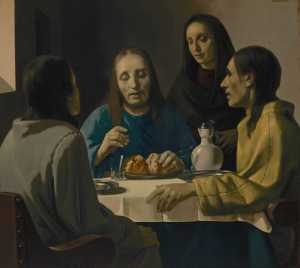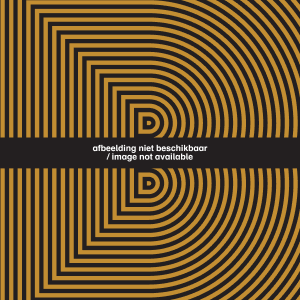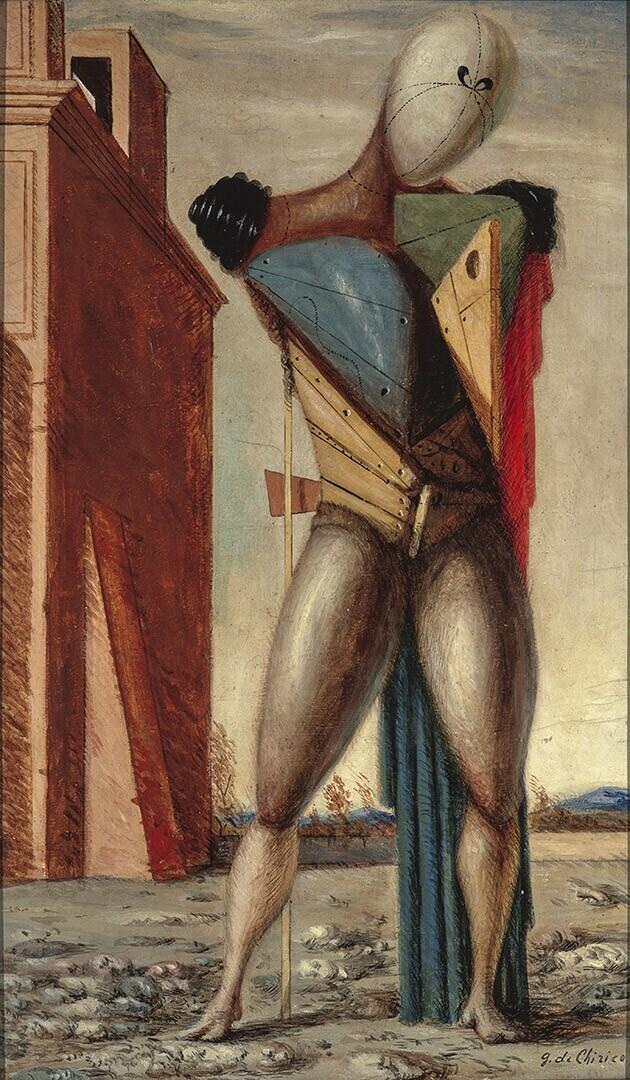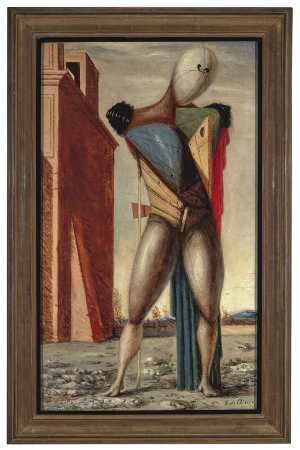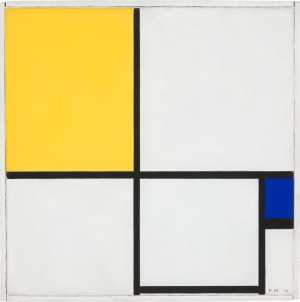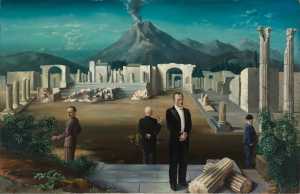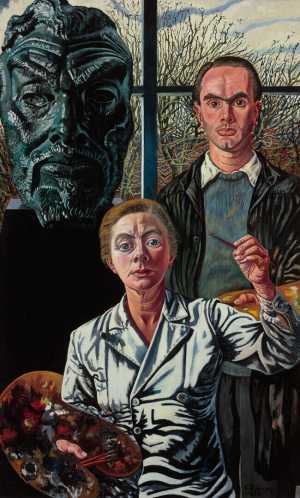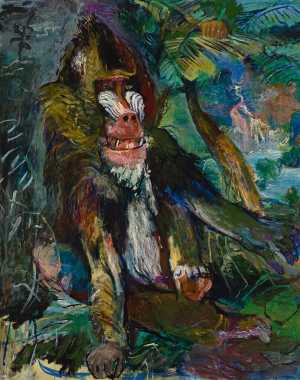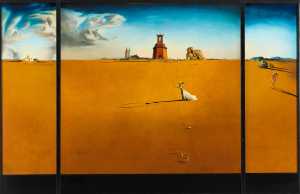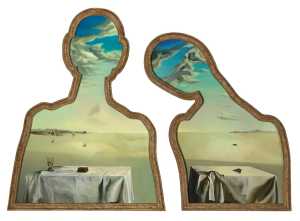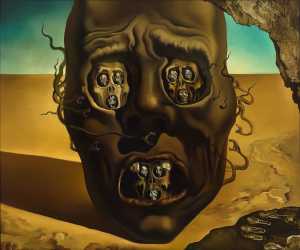This early work of De Chirico shows a creature, half human half lay figure, in an empty landscape with a colossal building. De Chirico wished to depict a mysterious meaning behind objects. His disturbing paintings are full of menace and alienation.

Specifications
| Title | Il trovatore |
|---|---|
| Material and technique | Oil on canvas |
| Object type |
Painting
> Painting
> Two-dimensional object
> Art object
|
| Location | This object is in storage |
| Dimensions |
Height 100 cm Width 65 cm Depth 7 cm |
|---|---|
| Artists |
Artist:
Giorgio de Chirico
|
| Accession number | St 125 |
| Credits | Loan Stichting Museum Boijmans Van Beuningen, 1965 |
| Department | Modern Art |
| Acquisition date | 1965 |
| Creation date | in circa 1924 |
| Provenance | Paul Éluard, Aubonne 1923-24; Galerie Le Centaure, Brussels 1924; Burthoul 1924-50; Galerie Georges Giroux, Brussels 1950; J.B. Urvater, Sint-Genesius-Rode 1950-65 |
| Exhibitions | Brussels 1963; Rotterdam 1996a; Rotterdam 2000a; Padua 2007; London/Rotterdam/Bilbao 2007-08; Rotterdam 2013-14a; Rotterdam 2017b |
| Internal exhibitions |
The Collection Enriched (2011) Een paraplu, een naaimachine en een ontleedtafel. Surrealisme à la Dalí in Rotterdam. (2013) De collectie als tijdmachine (2017) Collectie - surrealisme (2017) |
| External exhibitions |
Power Mask. The Power of Masks (2017) Dal nulla al sogno (2018) |
| Research |
Show research A dream collection - Surrealism in Museum Boijmans Van Beuningen |
| Literature | London/Rotterdam/Bilbao 2007-08, p. 208, cat. no. 28; Klar 2007, p. 28; Rotterdam 2007, pp. 40-41; Alechinsky/Jacqmain/Roberts-Jones 2013, p. 107, fig. 89; Strinati/Picozza 2014, p. 53, cat. no. 34 |
| Material | |
| Object | |
| Geographical origin | Italy > Southern Europe > Europe |
Entry catalogue A dream collection - Surrealism in Museum Boijmans Van Beuningen
Author: Marijke Peyser

In 1917 Giorgio de Chirico painted a work entitled Il trovatore. The painting shown here is a later version. A monumental dummy or mannequin fills the canvas, its size giving it a surprising relationship with the architectural fragment on the left. The mannequin’s head is egg-shaped, lacking details. Wooden boards in various colours and sizes represent the upper body and both shoulders have been replaced with black turned knobs. A red and blue cloth falls to the ground in classical folds behind the left leg. The surroundings are desolate, bordered at the low horizon by some trees and a mountain landscape. De Chirico wrote about the mannequins that made their debut in his oeuvre in 1914: ‘The idea of these large heads shaped like an egg, which one also sees in my standing mannequins of the metaphysical type, came to me from seeing the maquettes designed by my brother who used the pseudonym Alberto Savinio. My brother, who was a writer, musician and painter, wrote a play entitled Les chants de la mi-mort in 1914. The protagonist is a “man without voice, without eyes or face”.’[1] The body played an important role in all its forms in Surrealist thinking. André Breton described mannequins in shop windows as ‘marvellous and whose still forms embodied both economic and erotic availability and consumption.’[2]
Guillaume Apollinaire, one of the most influential figures of the Parisian avant-garde, shared De Chirico’s interest in the poetic meanings of everyday things: Italian squares with artificial perspectives, deep shadows, mysterious classical statues and objects that logically did not belong.[3] Responding to Apollinaire’s regard for De Chirico, Breton and other members of the Surrealist movement welcomed him into their midst. De Chirico did not in fact see himself as a Surrealist, but the metaphysical works he had made in the 1910s were an important source of inspiration for painters such as Max Ernst, Salvador Dalí, Paul Delvaux and René Magritte.[4]
The first owners of the second version of Il trovatore were Gala and Paul Éluard, whom De Chirico visited in Rome in the winter of 1923. It is possible that the painter made this variation on the 1917 work at Éluard’s request.[5] When De Chirico moved back to Paris in 1925, Breton and the other Surrealists were very dismissive of his post-war works. However around 1918, well before the discovery of his metaphysical work by the Surrealists in the 1920s, De Chirico had already taken an entirely different course by making classical-looking paintings. Breton’s initial praise gave way to severe criticism.[6] De Chirico was reproached for making woeful copies of great masters and repeating his own work. Il trovatore and Au seuil de la liberté by Magritte and Le couple by Ernst were the first three Surrealist works in Museum Boijmans Van Beuningen’s collection. They were acquired together by the museum from the renowned collection of the Belgian couple Joseph Berthold (Bertie) and Gaëtane (Gigi) Urvater.[7]
Footnotes
[1] London 1990, p. 81.
[2] London/Rotterdam/Bilbao 2007-08, pp. 119-37 and esp. p. 122.
[3] Los Angeles 2011 p. 15, note 56: Apollinaire was the first writer to use the term ‘metaphysical painting’ about the paintings De Chirico made between 1909 and 1919.
[4] Gibson 1997b, pp. 196, 369.
[5] London/Rotterdam/Bilbao 2007-08, p. 308, quoted from Gateau 1982, pp. 97-98.
[6] Breton 1965, p. 60.
[7] For the purchasing history see Van Kampen-Prein in in this publication, pp. 22-25.


